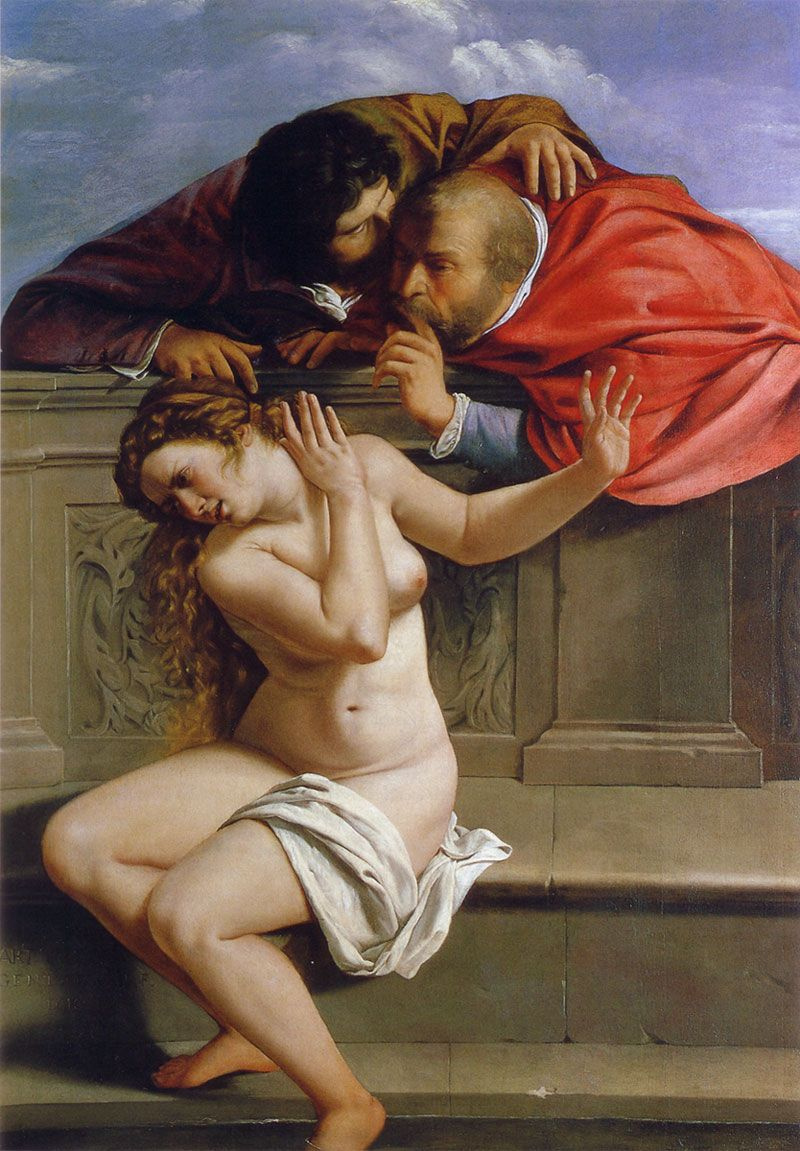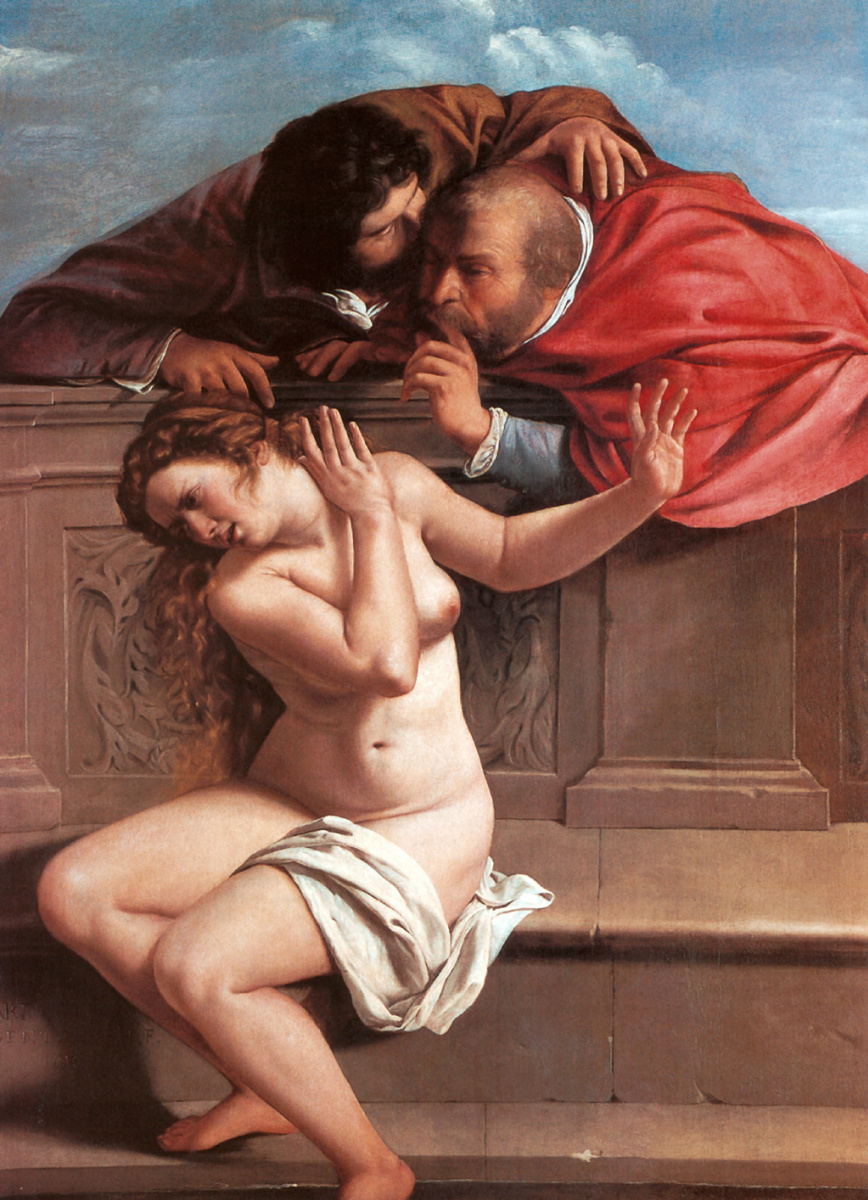log in
Enter site
Login to use Arthive functionality to the maximum
Susanna and the Elders
Artemisia Gentileschi • Painting, 1610, 170×119 cm
Description of the artwork «Susanna and the Elders»
The Italian artist Artemisia Gentileschi was only seventeen when she, a diligent student of her father, Orazio Gentileschi, painted Susanna and the Elders. Two things are amazing about this. First, an unusually confident and energetic manner, which is the least expected from a young person. And secondly, the artist’s obvious foresight: Artemisia would repeat the fate of the biblical Susanna very soon.
Susanna (after European tradition; in Hebrew — שׁוֹשַׁנָּה, Šošana) is a Jew woman who lived with her husband Joachim at the court of the Babylonian king Nebuchadnezzar. Like other Jews (including the prophet Daniel), they ended up in Babylon as captives, however, thanks to their talents, they were able to take a high position. Susanna possessed a rare beauty. Once, when she was bathing in her garden when two lustful elders who held the high state posts saw her. Lusting for Susanna and seeking intimacy, they accost her, threatening to claim that she was meeting a young man in the garden unless she agrees to have sex with them. But Susanna chose the unfair accusations. For the crimes not committed, the court sentenced her to death. Fortunately, the prophet Daniel was able to restore justice by interrogating the elders separately, and then together — that is, by organizing something like a confrontation. Both were executed for perjury.
A similar story is found in 1001 Nights, but its origins are the Old Testament. The Orthodox do not consider the legend of Susanna canonical, though it is included in the text of the Old Testament. It is in the Greek translation of the Book of the Prophet Daniel and the story has become extremely popular in pictorial art since the Renaissance. Pinturicchio and Lorenzo Lotto, Veronese and Tiepolo, Jacopo Tintoretto and Jacopo da Ponte Bassano have their own Saint Susanna. After the Italians, the Dutch became interested in Susanna, the subject was actively used by Rubens (1, 2), as well as Van Dyck and Rembrandt. In many of those works, erotic overtones are very strongly expressed, but not in Artemisia’s one. Her Susanna is, first of all, a sacrifice, an immaculate “white lily” (this is how her name is translated from Hebrew). Gentileschi tells the story from a woman’s point of view, makes the audience empathize with his subject.
Artemisia was close to the topic of violence and unfair accusations like no one else. At the age of 17—18, she was raped by the artist Agostino Tassi, a companion and friend of her father, and then agreed to a relationship with Tassi for a year, not knowing that, firstly, he had already been accused of rape more than once, but secondly, he was married. The case was made public. For seven months, gruelling trials lasted. Artemisia Gentileschi tried to prove that she lived with Tassi under duress, which made her surpass a public gynaecological examination, interrogation and even torture. As a result, Tassi’s guilt was proven. He received a year in prison, and Artemisia — a dramatic but invaluable experience that would greatly affect her work. The themes of violence and retaliation would become dominant for the artist (she will return to the same subject).
Some of the researchers remarked that in this picture, we can see one of the most natural female busts in the history of art: the breasts sagged a little under their own weight, even the folds under the arm are drawn realistically. This is precisely the woman’s approach to both the portrayal of nature and the very interpretation of the subject.
Susanna and the Elders is housed in the Weißenstein Castle now, a magnificent Baroque palace, the pearl of Bavaria, in the same collection as Titian, Rubens, and Van Dyck. The painting does not fade against their background, testifying that Artemisia Gentileschi was one of the most prominent artists of the Baroque era.
Author: Anna Vcherashnia
Susanna (after European tradition; in Hebrew — שׁוֹשַׁנָּה, Šošana) is a Jew woman who lived with her husband Joachim at the court of the Babylonian king Nebuchadnezzar. Like other Jews (including the prophet Daniel), they ended up in Babylon as captives, however, thanks to their talents, they were able to take a high position. Susanna possessed a rare beauty. Once, when she was bathing in her garden when two lustful elders who held the high state posts saw her. Lusting for Susanna and seeking intimacy, they accost her, threatening to claim that she was meeting a young man in the garden unless she agrees to have sex with them. But Susanna chose the unfair accusations. For the crimes not committed, the court sentenced her to death. Fortunately, the prophet Daniel was able to restore justice by interrogating the elders separately, and then together — that is, by organizing something like a confrontation. Both were executed for perjury.
A similar story is found in 1001 Nights, but its origins are the Old Testament. The Orthodox do not consider the legend of Susanna canonical, though it is included in the text of the Old Testament. It is in the Greek translation of the Book of the Prophet Daniel and the story has become extremely popular in pictorial art since the Renaissance. Pinturicchio and Lorenzo Lotto, Veronese and Tiepolo, Jacopo Tintoretto and Jacopo da Ponte Bassano have their own Saint Susanna. After the Italians, the Dutch became interested in Susanna, the subject was actively used by Rubens (1, 2), as well as Van Dyck and Rembrandt. In many of those works, erotic overtones are very strongly expressed, but not in Artemisia’s one. Her Susanna is, first of all, a sacrifice, an immaculate “white lily” (this is how her name is translated from Hebrew). Gentileschi tells the story from a woman’s point of view, makes the audience empathize with his subject.
Artemisia was close to the topic of violence and unfair accusations like no one else. At the age of 17—18, she was raped by the artist Agostino Tassi, a companion and friend of her father, and then agreed to a relationship with Tassi for a year, not knowing that, firstly, he had already been accused of rape more than once, but secondly, he was married. The case was made public. For seven months, gruelling trials lasted. Artemisia Gentileschi tried to prove that she lived with Tassi under duress, which made her surpass a public gynaecological examination, interrogation and even torture. As a result, Tassi’s guilt was proven. He received a year in prison, and Artemisia — a dramatic but invaluable experience that would greatly affect her work. The themes of violence and retaliation would become dominant for the artist (she will return to the same subject).
Some of the researchers remarked that in this picture, we can see one of the most natural female busts in the history of art: the breasts sagged a little under their own weight, even the folds under the arm are drawn realistically. This is precisely the woman’s approach to both the portrayal of nature and the very interpretation of the subject.
Susanna and the Elders is housed in the Weißenstein Castle now, a magnificent Baroque palace, the pearl of Bavaria, in the same collection as Titian, Rubens, and Van Dyck. The painting does not fade against their background, testifying that Artemisia Gentileschi was one of the most prominent artists of the Baroque era.
Author: Anna Vcherashnia



